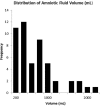Accuracy of Blood Loss Measurement during Cesarean Delivery
- PMID: 28497007
- PMCID: PMC5425292
- DOI: 10.1055/s-0037-1601382
Accuracy of Blood Loss Measurement during Cesarean Delivery
Abstract
Objective This study aims to compare the accuracy of visual, quantitative gravimetric, and colorimetric methods used to determine blood loss during cesarean delivery procedures employing a hemoglobin extraction assay as the reference standard. Study Design In 50 patients having cesarean deliveries blood loss determined by assays of hemoglobin content on surgical sponges and in suction canisters was compared with obstetricians' visual estimates, a quantitative gravimetric method, and the blood loss determined by a novel colorimetric system. Agreement between the reference assay and other measures was evaluated by the Bland-Altman method. Results Compared with the blood loss measured by the reference assay (470 ± 296 mL), the colorimetric system (572 ± 334 mL) was more accurate than either visual estimation (928 ± 261 mL) or gravimetric measurement (822 ± 489 mL). The correlation between the assay method and the colorimetric system was more predictive (standardized coefficient = 0.951, adjusted R2 = 0.902) than either visual estimation (standardized coefficient = 0.700, adjusted R2 = 00.479) or the gravimetric determination (standardized coefficient = 0.564, adjusted R2 = 0.304). Conclusion During cesarean delivery, measuring blood loss using colorimetric image analysis is superior to visual estimation and a gravimetric method. Implementation of colorimetric analysis may enhance the ability of management protocols to improve clinical outcomes.
Keywords: blood loss measurement; cesarean delivery; postpartum hemorrhage; quality improvement.
Conflict of interest statement
Figures








Similar articles
-
Limitations of Gravimetric Quantitative Blood Loss during Cesarean Delivery.AJP Rep. 2022 Feb 4;12(1):e36-e40. doi: 10.1055/s-0041-1742267. eCollection 2022 Jan. AJP Rep. 2022. PMID: 35141034 Free PMC article.
-
Quantification of Intraoperative Blood Loss in a Simulated Scenario Using a Novel Device.Shock. 2021 Jun 1;55(6):759-765. doi: 10.1097/SHK.0000000000001615. Shock. 2021. PMID: 32694398
-
Assessing gravimetric estimation of intraoperative blood loss.J Gynecol Surg. 1993 Fall;9(3):151-4. doi: 10.1089/gyn.1993.9.151. J Gynecol Surg. 1993. PMID: 10171989
-
Comparison of common perioperative blood loss estimation techniques: a systematic review and meta-analysis.J Clin Monit Comput. 2021 Apr;35(2):245-258. doi: 10.1007/s10877-020-00579-8. Epub 2020 Aug 19. J Clin Monit Comput. 2021. PMID: 32815042 Free PMC article.
-
Can measuring blood loss at delivery reduce hemorrhage-related morbidity?Int J Obstet Anesth. 2021 May;46:102968. doi: 10.1016/j.ijoa.2021.102968. Epub 2021 Mar 3. Int J Obstet Anesth. 2021. PMID: 33774489 Review.
Cited by
-
Do we visually estimate intra-operative blood loss better with white or green sponges and is the deviation from the real blood loss clinically acceptable? Results from a simulated scenario study.PLoS One. 2020 Oct 21;15(10):e0240808. doi: 10.1371/journal.pone.0240808. eCollection 2020. PLoS One. 2020. PMID: 33085701 Free PMC article.
-
Triton sponge and canister app for estimating surgical blood loss.Saudi J Anaesth. 2019 Oct-Dec;13(4):390-391. doi: 10.4103/sja.SJA_38_19. Saudi J Anaesth. 2019. PMID: 31572095 Free PMC article. No abstract available.
-
Limitations of Gravimetric Quantitative Blood Loss during Cesarean Delivery.AJP Rep. 2022 Feb 4;12(1):e36-e40. doi: 10.1055/s-0041-1742267. eCollection 2022 Jan. AJP Rep. 2022. PMID: 35141034 Free PMC article.
-
Hemodynamic effects of carbetocin administered as an intravenous bolus or infusion during cesarean delivery.Anesth Pain Med (Seoul). 2020 Apr 30;15(2):167-172. doi: 10.17085/apm.2020.15.2.167. Epub 2020 Apr 29. Anesth Pain Med (Seoul). 2020. PMID: 33329809 Free PMC article.
-
Calculation methods for intraoperative blood loss: a literature review.BMC Surg. 2024 Dec 20;24(1):394. doi: 10.1186/s12893-024-02699-3. BMC Surg. 2024. PMID: 39707278 Free PMC article. Review.
References
-
- Callaghan W M, Kuklina E V, Berg C J. Trends in postpartum hemorrhage: United States, 1994-2006. Am J Obstet Gynecol. 2010;202(04):3530–3.53E8. - PubMed
-
- Berg C J, Harper M A, Atkinson S M et al.Preventability of pregnancy-related deaths: results of a state-wide review. Obstet Gynecol. 2005;106(06):1228–1234. - PubMed
-
- Lyndon A, Lagrew D, Shields L, Main E, Cape V. Improving Health Care Response to Obstetric Hemorrhage. (California Maternal Quality Care Collaborative Toolkit to Transform Maternity Care) Developed under contract #11–10006 with the California Department of Public Health; Maternal, Child and Adolescent Health Division; Published by the California Maternal Quality Care Collaborative, 3/17/15. Available at: http://health.utah.gov/uwnqc/documents/CaliforniaToolkittoTransformMater.... Accessed August 1, 2016
-
- Main E K, Goffman D, Scavone B M et al.National Partnership for Maternal Safety: consensus bundle on obstetric hemorrhage. Anesth Analg. 2015;121(01):142–148. - PubMed
-
- Brasel K J, Guse C, Gentilello L M, Nirula R. Heart rate: is it truly a vital sign? J Trauma. 2007;62(04):812–817. - PubMed
Publication types
LinkOut - more resources
Full Text Sources
Other Literature Sources

